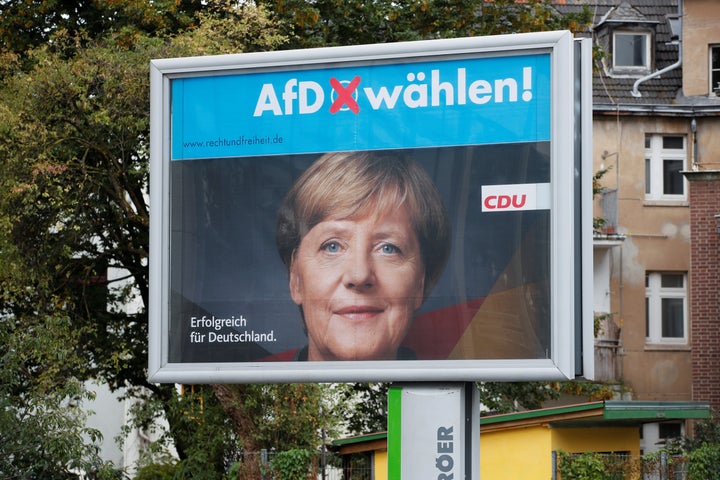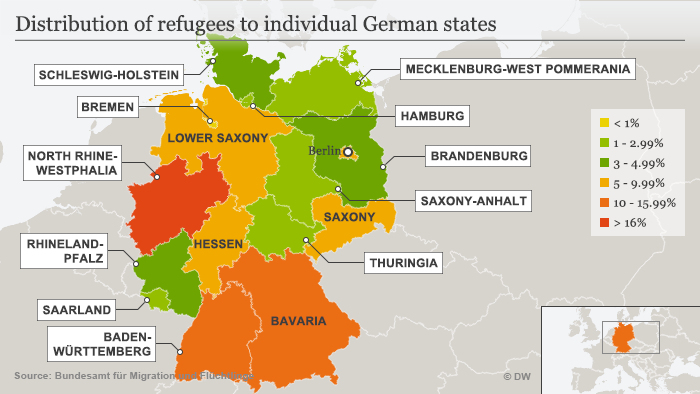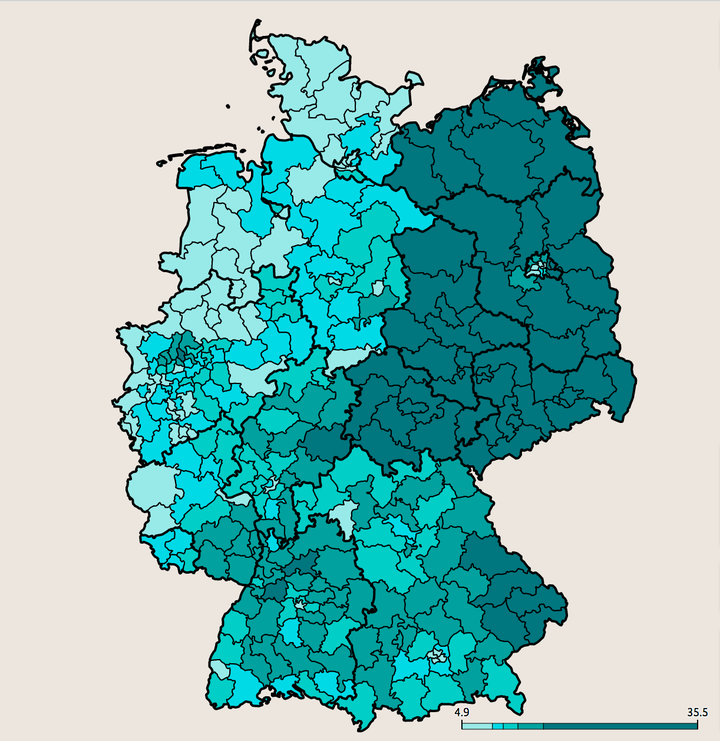
The East German state of Saxony is a long way from Ohio, but the two places have a lot in common. Abandoned factories are falling into ruins in both places. There is fear, anger, and despair in the cities and countryside. People are dissatisfied with the status quo and the politicians that represent it.
There is an element of the “Trump voter” phenomenon in Germany’s recent election results. But a deeper global phenomenon is at work, and it has implications for the American future. That political phenomenon known as “centrism,” whose policies reflect the worldview of long-entrenched global and political elites, is collapsing. The question now is, what will take its place?
A Slow Decline
Angela Merkel and her ruling Christian Democratic Union Party were returned to power, but with a far weaker showing than expected. Merkel’s party had its worst electoral performance since 1949. The far-right Alternative for Germany (did someone say “alt-right”?) party, or AfD, did much better than predicted with 12.6 percent of the vote.
The neofascist AfD has an anti-Muslim, anti-immigrant message that features a call for “negative immigration” and a ban on headscarves, as well as the return of some political processes that were banned after their misuse by Hitler.
AfD politicians have criticized the Holocaust memorial (saying Germans were the “only people in the world who planted a memorial of shame in the heart of their capital”) and attempted to rehabilitate the word völkisch, which was used by the Nazis to idealize and elevate what they saw as uniquely German qualities. (Jews, Roma, and LGBT people, for example, did not possess those qualities.) AfD leaders have clouded its bigotry and fascism with a contradictory comments that are either the product of intraparty divisions or part of an orchestrated good cop/bad cop routine. (It’s probably a little of both.)
AfD did especially well in the formerly Communist German Democratic Republic. It received 27 percent of the total vote in Saxony, for example, where protestors drew national attention last year by surrounding and terrifying refugee women and children being taken to a hostel. Overall, the AfD outperformed its national results in the rural areas of eastern Germany. One newspaper called it “the revenge of the East.”
In a phenomenon seen in the United States and elsewhere, anti-immigrant sentiment was not greatest in areas that have seen the most immigration. The opposite is true, in fact, as these two maps show:

Source: Deutsche Welle

Source: Daily Express
The green in the first map shows the areas of lowest refugee resettlement. The dark areas of the second map show where AfD gained the most votes. The regions that went most heavily for the AfD are the areas with the fewest resettled refugees. Some other factors must be contributing to both the hatred and the support for AfD.
How Do You Say “MAGA” in German?
Is the AfD phenomenon an echo of Trumpism in the US and far-right movements in France, Great Britain, and other European countries? It would appear that way, although other forces are also at work.
Are AfD voters simply racist “deplorables” whose hatreds have finally been unleashed, or arere they channeling economic despair into fear of outsiders? It’s rarely just one or the other. Social forces like bigotry and economic conditions are linked to each other in a chain of causality, making interpretation difficult. But something more than hatred and xenophobia seems to be at work in the German electorate.
As the Financial Times reports, the fiscal conservatism of Germany’s ruling centrists led to a significant downsizing of government services after eastern Germany merged with the west. According to a German professor cited by the Times, the resulting lack of services - “where you have to travel 60km to the nearest district court to get a living will or . . . have a car registered” - enraged much of the East’s population, leaving them feeling socially and politically excluded.
Behind the Miracle
The professor, Hajo Funke, sees three pillars of AfD support: these disaffected voters, the far right, and protest voters. Protest voters were the largest group of all, in fact, according to exit polls. They showed that 60 percent of AfD votes were directed “against all other parties,” while only 34 percent supported the AfD itself. That’s an extremely high number. That doesn’t mean that anti-immigrant sentiment wasn’t a key motivator; it was. 85 percent of AfD’s voters want tougher border policies, while 89 percent thought that Merkel’s pro-immigrant policies ignored “the concerns of the (German) people.”
But xenophobia tends to rise in times of economic insecurity. And despite Germany’s overall economic strength, its prosperity has not been equally shared among all its people. Salaries and pensions in the east are lower than they are in the west. Eastern Germany’s per capita GDP is only 73 percent that of western Germany, making it significantly less prosperous. Unemployment is two points higher there.
There are other cracks in Germany’s economic miracle. Long-term unemployment is a persistent problem, even though there are labor shortages in some areas, and 7 percent of Germans are employed at part-time “mini-jobs” that leave them in economic peril. Many of the factories in Germany’s eastern “rust belt” have been shut down, leading to localized pockets of joblessness and underemployment.
Inequality is rising, as 27 percent increase in income for the wealthiest 10 percent was matched by an income decline of 8 percent at the lower end of the income spectrum. 82 percent of German voters think inequality has become too pronounced, and it became an issue in this year’s election.
The percentage of Germans at risk of falling into poverty has risen from 11 percent to 16 percent over the last two decades. The gap between rich and poor has widened since the reunification of Germany in 1991, and Germany’s lowest earners haven’t seen their incomes rise in 15 years.
The AfD drew a large number of first-time voters, which suggests that its message resonated with people who previously felt that nobody was speaking for them. That may have implications for the United States, where presidential voter turnout hit a 20-year low last year and nearly half the electorate failed to show up at the polls.
Base to Democrats: Come In, Please.
U.S. workers are struggling too. The American middle class is rapidly disappearing. White working-class males saw their incomes fall by nine percent between 1996 and 2014.
But the media fixation on Trump voters only tells part of the story. Lower turnout among core Democratic voters also contributed to the party’s 2016 losses. As Matt Bruenig of the People’s Policy Project notes, only the top 2 percent of African-American households did well during the Obama years. Overall, black wealth plunged.
That suggests, when it comes to voter turnout, that the Barack Obama/Hillary Clinton campaign strategy of touting the economy’s progress was ill-advised at best. Black voter turnout declined from 72 percent to 62 percent from 2012 to 2016 in Ohio, a battleground state that was hard-hit by the loss of manufacturing jobs.
Without a new economic agenda, the turnout problem could get even worse for Democrats. A recent survey of African-American voters in Ohio, conducted by Working America, found “a profound disconnect — especially on economic issues — between working-class African-American voters and the Democratic Party.”
“If black voter turnout remains depressed in 2018,” the report adds, “it will doom Democrats’ chances in Ohio’s upcoming elections for the U.S. Senate, governor and state legislature.”
“We heard repeatedly about voters’ struggles with declining wages, underemployment and unaffordable health care,” the authors write. Voters told canvassers they were discouraged about their future and did not hear politicians telling them how they would make it better. As the report concludes:
“Progressive politicians need to boldly address black voters’ concerns, many of which white working-class voters share.”
Young voters have traditionally been another Democratic mainstay. But Democrats who chastise millennials for their lack of enthusiasm should note that poverty has risen dramatically among under-35 households. Home ownership is down. As of 2016, youth unemployment had fully recovered from the 2008 recession in only four states. And student debt, which now exceeds $2.5 trillion, is burdening millions of millennials with debt before they even embark on their careers.
As pollster and political strategist Stanley R. Greenberg writes: “The Democrats don’t have a ‘white working-class problem.’ They have a ‘working-class problem.’”
Past and Future
From the banks of the Ohio River to the Ore Mountains in Saxony, discontent and fear are on the rise. It’s been a long time coming. Through Republican and Democratic administrations in the United States, and through social democratic and Christian democratic governments in Western Europe, an elite consensus held to certain core principles: Government deficits must be reined in. Government services must be privatized. “Free trade,” unhampered by democratic oversight or strong labor and environmental regulations, must be expanded.
The end result has been a loss of social services, the erosion of worker rights, and growing fears about the future.
The “centrist” elite is losing ground. The question is, what will replace it? While the AfD’s gains were striking, German progressive parties still outperformed it. The left-wing Die Linke party won 9.2 percent of the vote, and the Greens took 8.9 percent, for a combined total of 18.1 percent. But the combined left saw only slight growth, while the AfD’s support spiked. That’s disturbing.
Tony Blair, cheerleader for this crumbling edifice of centrism, continues to stump for something he calls “the vigorous change-making center.” But Blair’s “center” had decades of “change-making” power and failed. Its slow, ongoing collapse could lead to something better, as the campaigns of Bernie Sanders in the US and Jeremy Corbyn in Great Britain have shown. Or it could lead to something much, much worse.
“If you get stuck on what I call the sort of hard shoulder of nostalgia,” Blair said, “the world is just going to pass you by.”
He doesn’t know it, but he’s talking about himself and his fellow “centrists.” They’re rapidly fading into the past, as they should. The question now is, who will shape the future?
